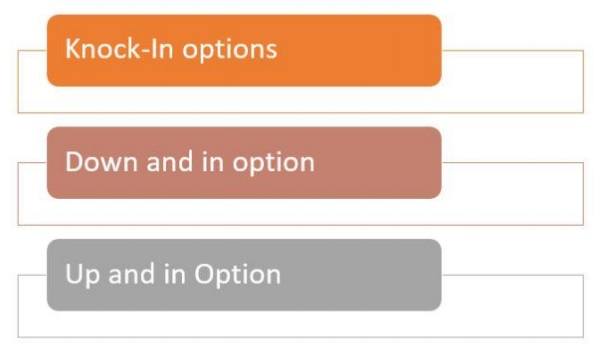
 Data Structure
Data Structure Networking
Networking RDBMS
RDBMS Operating System
Operating System Java
Java MS Excel
MS Excel iOS
iOS HTML
HTML CSS
CSS Android
Android Python
Python C Programming
C Programming C++
C++ C#
C# MongoDB
MongoDB MySQL
MySQL Javascript
Javascript PHP
PHP
- Selected Reading
- UPSC IAS Exams Notes
- Developer's Best Practices
- Questions and Answers
- Effective Resume Writing
- HR Interview Questions
- Computer Glossary
- Who is Who
What is Knock-In Option and how does it work?
A knock-in option is a latent option contract that becomes active as a regular option contract only when a specific price level is achieved before the option contract's expiry date. In the construction industry, knock-ins are a kind of barrier that may be categorized as both a down-and-in or an up-and-in. In financial markets, an option on a barrier security is a kind of agreement in which the payment is contingent on the underlying asset's price or even if it reaches a specific price within a defined time period.
Types of Knock-in Options

Key Points Briefly
When the underlying asset's price hits a particular defined barrier, a knock-in option is activated. Knock-in options are a kind of barrier option in which the option is triggered only when the underlying asset's price meets the specified barrier.
In terms of knock-in choices, there are two kinds to choose from: the down and in option and the up and in option. In the first case, the option is activated only if the price of the underlying asset falls below a certain threshold. The latter kind of option is activated only if the price of the underlying asset increases to a specific level, and not before.
Knock-in Option - Different Types
-
The Down-and-In Knock-In Option
A down-and-in option is created when the price of an asset falls to a particular level, which is referred to as the barrier price, and then rises beyond it. The options contract is only triggered if the price of the underlying asset falls below the barrier price.
An activated options contract behaves in the same way as any other option contract by granting the opportunity holder the power to pursue the option at the strike price before the contract's expiry date before the contract's expiration date. The contract wont be initiated when the price doesn’t reduce.
-
Knock-in option − Up-and -in
When the barrier price of the asset is exceeded, the up-and-in option gets automatically triggered and the asset gets sold. If the asset's price never exceeds the barrier price, the options contract will be void and will not be able to be used.
Therefore an up-and-in call option is advantageous to the investor. A down-and-in put option, on the other hand, is advantageous to the investor when the price of the underlying asset is dropping.
Example of a Knock-In Option
Let us consider the example where an investor wants to buy stocks where the barrier price is $50, the strike price is at $60 and the asset price is at $70. Now if the price of the asset doesn’t reach the barrier price of $50, the contract wont be initiated.
However, once the price exceeds the barrier price set, in this case of $50, the contract gets automatically initiated with the price of $60, that is the strike price.
Down-and-in option gets activated when there is a fall in the asset pricing, and this gives control to the investor to sell the stock at $60 or the strike price. This gets activated once the price decreases below the barrier price.
To understand the up-and-in option, let us consider the situation where the price of stock exceeds the barrier price of $50. This initiates the contract automatically.

